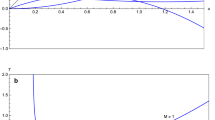Abstract
An important phenomenon in the gas–liquid two-phase mixtures is a sudden change in the flow that may lead to transition of the flow regime from non-homogeneous slip flow to homogenous flow. This phenomenon is called mixing shock and has been investigated by several researchers. In the present paper, a more comprehensive model is proposed by including the entrainment ratio in the governing equations. Moreover, parametric studies are performed to assess the importance of this parameter in different conditions. The results of the present study indicate that at Euler numbers less than four the effect of gas mass flow is insignificant. However, at higher Euler numbers the differences of the present and previous models are noticeable. Since two possible solutions for the aftershock state exist, four criteria—entropy change across the shock, possibility of an expansion shock, positivity of the Euler number, and choking flow condition—are considered to identify the correct solution. The results indicate that the flow after the shock could only be of a subsonic type, and the mixing shock is compressive. A comparison of the possible realizable zones for the developed model and the previous models indicates that the developed model predicts a larger area for the realizable solution of the mixing shock. A comparison between analytical results and experimental data shows that the developed model predicts reasonable results.











Similar content being viewed by others
Abbreviations
- A :
-
Area (\(\hbox {m}^{{2}}\))
- a :
-
Euler number
- \(a^{*}\) :
-
Smallest curve’s Euler number
- c :
-
Speed of sound (m/s)
- \(c_{p}\) :
-
Specific heat capacity (J/kg)
- D :
-
Diameter (m)
- f :
-
Gas–liquid volume fraction ratio
- G :
-
Mass flow rate per unit area (kg/(\(\hbox {m}^{{2}}\) s))
- \({\dot{m}}\) :
-
Mass flow rate (kg/s)
- M :
-
Mach number
- N :
-
Number of holes in the liquid nozzle
- P :
-
Pressure (Pa)
- Q :
-
Volumetric flow rate (\(\hbox {m}^{{3}}\)/s)
- R :
-
Gas constant (J/(kg K))
- S :
-
Entropy (J/K)
- T :
-
Temperature (K)
- v :
-
Velocity (m/s)
- x :
-
Gas quality
- Z :
-
Distance between the liquid nozzle exit and the mixing tube entrance (m)
- \(\alpha \) :
-
Gas volume fraction
- \(\varepsilon \) :
-
Pressure ratio across the shock
- \(\theta \) :
-
Gas–liquid volume flow ratio
- \(\lambda \) :
-
Dimensionless parameter
- \(\mu \) :
-
Viscosity (kg/(m s))
- \(\rho \) :
-
Density (\(\text {kg}/\hbox {m}^{{3}}\))
- \(\sigma \) :
-
Surface tension (N/m)
- \(\psi \) :
-
Dimensionless parameter
- \(\omega \) :
-
Gas–liquid mass flow ratio
- A:
-
Air
- g:
-
Gas phase
- kn:
-
Liquid nozzle holes
- L:
-
Liquid phase
- m:
-
Mixture
- n:
-
Liquid nozzle
- s:
-
Isentropic curve
- t:
-
Ejector’s mixing chamber
- top:
-
Curve’s maximum point
- W:
-
Water
- Witte:
-
Reference [2] research
- 1:
-
Before shock
- 2:
-
After shock
References
Brennen, C.E.: Fundamentals of Multiphase Flow. Cambridge University Press, Cambridge (2005). https://doi.org/10.1017/CBO9780511807169
Witte, J.H.: Mixing shocks in two-phase flow. J. Fluid Mech. 36(4), 639–655 (1969). https://doi.org/10.1017/S002211206900190X
Von Pawel-Rammigen, G.: Experiments on ejectors. M.S. dissertation, Pennsylvania State University (1936)
Campbell, I.J., Pitcher, A.S.: Shock waves in a liquid containing gas bubbles. Proc. R. Soc. Lond. A 243(1235), 534–545 (1958). https://doi.org/10.1098/rspa.1958.0018
Eddington, R.B.: Investigation of supersonic phenomena in a two-phase liquid-gas tunnel. AIAA J. 8, 65–74 (1970). https://doi.org/10.2514/3.5607
Cunningham, R.G.: Gas compression with the liquid jet pump. J. Fluids Eng. 96, 203–215 (1974). https://doi.org/10.1115/1.3447143
Narkis, Y., Gal-Or, B.: Two-phase flow through normal shock wave. J. Fluids Eng. 97(3), 361–365 (1975). https://doi.org/10.1115/1.3447315
Ismagilov, A.R., Spiridonov, E.K.: Operational process and characteristics of liquid-gas jet pumps with the ejected vapor-gas medium. Procedia Eng. 150, 247–253 (2016). https://doi.org/10.1016/j.proeng.2016.06.756
Witte, J.H.: Mixing shocks and their influence on the design of liquid-gas ejectors. Doctoral thesis, TU Delft (1962). http://resolver.tudelft.nl/uuid:aceb586d-fa3a-4a51-a352-55c7424a98bf
Collier, J.G.: Convective Boiling and Condensation. McGraw-Hill, New York (1994)
Ghiaasiaan, S.M.: Two-Phase Flow, Boiling and Condensation in Conventional and Miniature Systems, 2nd edn. Cambridge University Press, Cambridge (2017). https://doi.org/10.1017/9781316597392
Author information
Authors and Affiliations
Corresponding author
Additional information
Communicated by E. Timofeev.
Publisher's Note
Springer Nature remains neutral with regard to jurisdictional claims in published maps and institutional affiliations.
Rights and permissions
Springer Nature or its licensor (e.g. a society or other partner) holds exclusive rights to this article under a publishing agreement with the author(s) or other rightsholder(s); author self-archiving of the accepted manuscript version of this article is solely governed by the terms of such publishing agreement and applicable law.
About this article
Cite this article
Mollakouchakian, M., Emami, M.D. Development of governing equations for mixing shocks in two-phase flows. Shock Waves 33, 357–368 (2023). https://doi.org/10.1007/s00193-023-01140-7
Received:
Revised:
Accepted:
Published:
Issue Date:
DOI: https://doi.org/10.1007/s00193-023-01140-7




